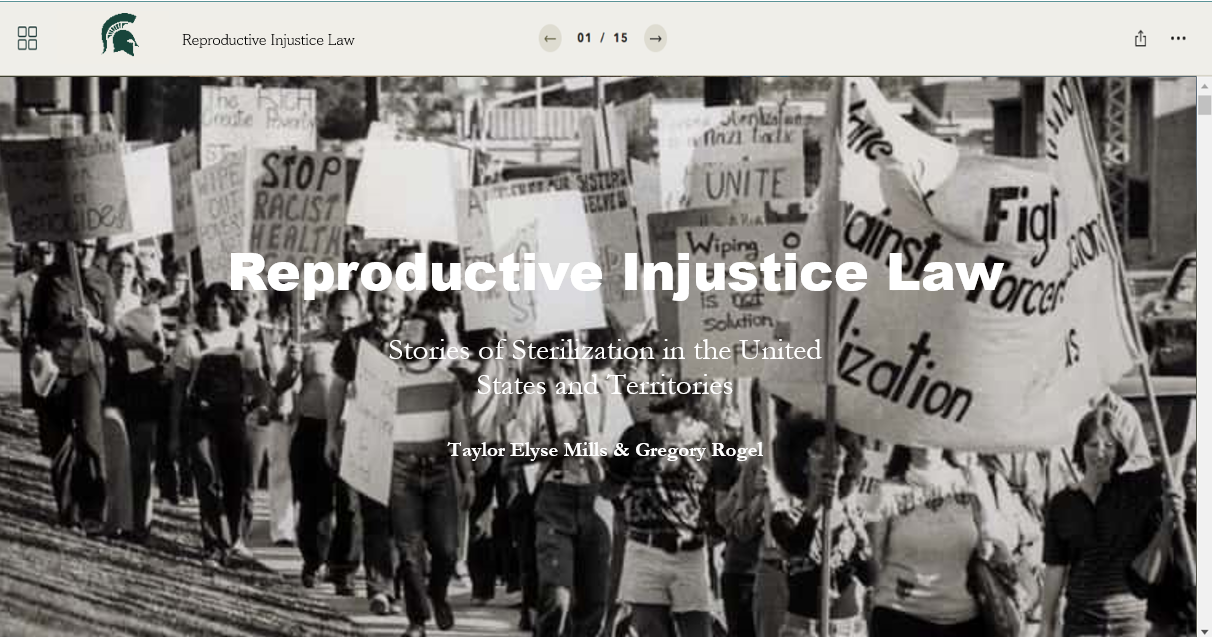Seed Grant Summer 2024 Report
Taylor Elyse Mills and Gregory Rogel
Background
With the overturn of Roe v. Wade and current, continued reports of forced sterilization of immigrant women in recent years, our timely project aims to track and map the history of legal precedent that has enabled the forced sterilization of women (and those who gestate) of color in the United States and U.S. territories, with particular emphasis on migrant/immigrant and Indigenous communities. The history of this grave reproductive injustice is under-researched in philosophy, bioethics, and in law. By bringing these disciplines together, we aim to provide a comprehensive overview of the legal system’s colonial pathways for forced sterilization, and the unique impact it has had on Latinx immigrant and Indigenous communities. Our project seeks to serve as powerful a research testimony that can bridge the gap between policy discourse and the lived experiences of the Latinx and Indigenous communities, fostering a more empathetic and nuanced approach to immigration policy and enforcement.
For the 2024 summer term, we had the following goals:
- Gather data in legal and biomedical contexts to aggregate under-researched and scattered statistics about the history of sterilization in the United States.
- Visit prominent archives such as the Center for Oral History Research at Cal State Fullerton and the UCLA Chicano Studies Research Center to gather additional data, particularly from a narrative perspective, about the lives and experiences of those who have been sterilized.
- Research and draft an overview of the history of sterilization from political, legal, and biomedical perspectives to use as the starting point for a publication.
- Begin constructing a map with the collected data to tell the story and impact of sterilization in the United States through stories, caselaw, and statistics.
Project Description
As stated, the overarching project aims to bridge the gap between policy discourse and the histories and experiences of communities impacted by sterilization. Addressing this gap is important since immigration policies are consistently contentious and in need of reform. In particular, this project draws from historical data and narratives to inform the present because forced sterilizations are continuing to happen today, especially with detained Latinx women.
For this summer, we tackled this goal primarily through data collection from various sources. In addition to legal research, we were committed to archive research in efforts to humanize the data through testimonies. In doing so, we aimed to explicate and then map the intricate web of social, economic, and political elements that exacerbate health disparities within these communities stemming from decades of forced sterilization.
First we gathered as much data as we could from publicly accessible resources and legal databases like Westlaw. Collecting data from these legal and statistical report sources proved challenging because the data is not available in raw formats. For example, we would find an approximate number of sterilizations occurring in a particular state, but no breakdown in years or demographics. The process was rather piece-meal but eye-opening about the fact that our project is necessary as the first intersectional, multidisciplinary effort to tackle this problem.

Next we visited the archives at the Center for Oral History Research at Cal State Fullerton, the UCLA Chicano Studies Research Center, and the Human Betterment Foundation archive at Cal Tech. We focused on gathering additional data, particularly narrative accounts, about the experiences of individuals who have been sterilized. The process entailed reviewing and analyzing various documents, piecing together information to construct an understanding of the Eugenics movement. Throughout this endeavor, we maintained detailed records of our findings while adhering strictly to data privacy protections, ensuring the ethical handling of sensitive information.
Then we began researching the history of eugenics and sterilization from our respective disciplines in philosophy, bioethics, and jurisprudence. The process was like a puzzle in which we would put together time period pieces together to see a larger image of the social, economic, political, and medical forces at work to produce this history.
Finally, we began mapping our findings. The majority of this stage involved discussions about what mapping platform we wanted to use because each platform offers different types of impacts. We decided that because we wanted our project to, as much as possible, put the communities’ voices at the forefront of telling this narrative, that Storymaps was our best avenue.
Outcomes
- Preliminary Analysis
Our preliminary analysis has revealed potential patterns in the historical practice of sterilization, disproportionately affecting women of color. For example, documents from institutions across the country indicate a widespread embrace of eugenic ideas, with many signaling their eagerness to learn more about or participate in these endeavors. This preliminary work lays the foundation for a more comprehensive analysis of how these historical practices have shaped and potentially continue to influence contemporary reproductive rights issues, especially among marginalized communities. - Article Draft
Though not complete, we have a first draft of the major sections of a paper we will submit for publication. In this respect we were able to pull together the research we had conducted in our respective disciplines to craft a multidisciplinary narrative about the history and current concerns about sterilization in the United States, with particular attention to Latinx immigrant communities. - Preliminary Mapping
Once we decided on using Storymaps, we began plotting some points to tell the story of sterilization from a multidisciplinary, multigenerational perspective. The map is still being developed but we are pleased with the direction that the map is going in.

Reflections and Future Directions
Our research has encountered unexpected challenges in accessing detailed historical medical records due to stringent privacy protections. We underestimated the extent of these privacy concerns and the requirement for IRB approval to examine sensitive personal data. We hope to obtain the IRB soon. Once obtained, this information will significantly enhance our understanding of how these practices were implemented and discussed at an individual level. This will also allow us to finalize our research paper and digital map project.